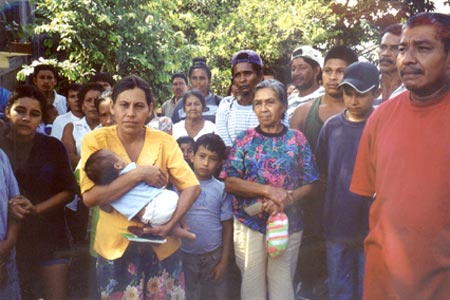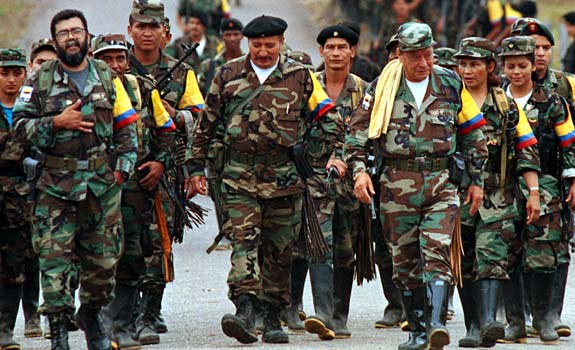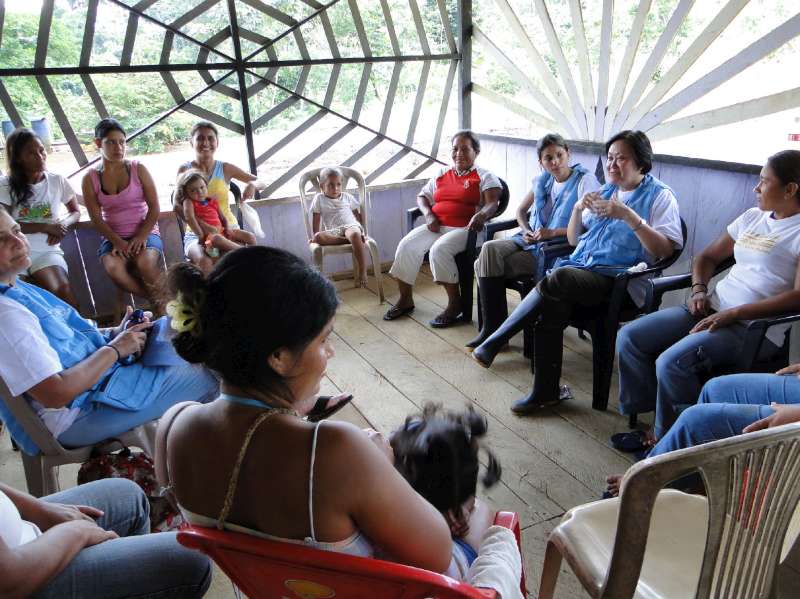Cocaine’s Forgotten Victims
Each year, thousands of Colombian peasants, primarily women and children, trek through the Amazon with their meager possessions, seeking asylum from the violence encompassing their traditional rural villages. Ecuador is home to the highest number of refugees to be found in Latin America, 98 percent of whom are Colombian. Most of these have fled the violence associated with coca cultivation and processing, as well as the violent after effects resulting from the U.S.-sponsored War on Drugs between narco-traffickers and security forces. This conflict has internally displaced an estimated 5 million Colombians, more than 300,000 of them fleeing over the particularly porous southern border with Ecuador. Despite political tensions between Ecuador and Colombia, the Ecuadorian government has welcomed Colombian refugees. However, these refugees often face severe discrimination and poor living conditions once they arrive in Ecuador, despite the efforts of hardworking NGOs such as the UN High Commissioner for Refugees (UNHCR).

Colombian-Ecuadorian Political Tensions
Political relations between Ecuador and Colombia in particular have been negatively impacted by Bogota’s implementation and subsequent expansion of Plan Colombia, a U.S.-sponsored counternarcotic initiative as part of Washington’s War on Drugs. Under this formula, the United States has spent over $8 billion USD to combat coca cultivation through military aid and fumigation programs in Colombia, which was the world’s largest coca producer of the illicit substance throughout the 1990s and early 2000s and supplied an estimated 90 percent of the cocaine sold in the U.S.[1] Correa has ardently opposed Plan Colombia, claiming that it has characteristically caused increased instability in the region and could violate both the national sovereignty of Andean countries and the human rights of Colombians. In addition, the Ecuadorian leader believes that the application of aerial fumigation of coca fields harms the health and adversely affects the crops of Ecuadorians living near the Colombian border. Correa claims that Colombia intentionally does not secure its southern region in an attempt to draw Ecuador into the drug war. In response, Ecuador, itself the home base to comparatively little coca cultivation due to a lack of ideal parcels of land that could be used to cultivate the crop, proposed “Plan Ecuador” in 2007, which aimed to protect the people living along the Colombian-Ecuadorian border from growing abuses of Plan Colombia.[2]
Tensions around the Colombian-Ecuadorian border came to a head in March 2008. The Colombian military carried out an air strike 1.1 miles across the Ecuadorian border on members of the leftist guerrilla group Fuerzas Armadas Revolucionarias de Colombia (FARC), which has long been involved in the coca trade in order to fund its underground fight against Colombian authorities. In turn, for years Bogotá had been a loyal ally of Washington and for the White House, and it was indeed difficult to separate the drug war from the Cold War. This operation resulted in the death of the FARC’s second in command Raúl Reyes and 24 additional members, including an Ecuadorian national. Nine hours later, President Uribe called President Correa during his weekly radio broadcast to inform him of the attack. While Bogotá claimed that its military was in hot pursuit of the FARC members and that the attacks on Ecuadorian soil were not premeditated, Quito officials asserted that it found some of those killed were wearing pajamas, casting doubt on whether the victims actively fought or tried to flee at the time of the attack. Correa referred to the attack as a massacre and claimed that the attack planes were flying north at the time of the attack, implying that the Colombian Air Force had flown even deeper into Ecuadorian territory, and thus had committed a direct violation of Ecuador’s airspace.
In response to Correa’s allegations, Colombian National Police Chief Oscar Naranjo claimed that three computers confiscated in the aftermath of the raid showed that the Ecuadorian government had been communicating with the FARC in an attempt to destabilize the Colombian government, an allegation that Ecuador was quick to deny. After the raid, both Ecuador and its close ally Venezuela severed diplomatic relations with Colombia by formally recalling their ambassadors and sending troops to their respective borders with Colombia. Despite the Rio Group summit on March 7, where the three leaders appeared to make amends over a handshake, animosity and suspicion have continued to persist between the Ecuadorian and Colombian authorities.[3] Even at this late date, clarity on what took place along the border has not been achieved.
Impact of Coca Cultivation on the Displacement of Colombians
North American and European demand for cocaine and other coca derivatives has fueled coca cultivation in the Andean region of South America since the 1970s. After serving primarily as a coca refinement and distribution center, Colombia became the world’s largest coca cultivator in the 1990s after the disruption in production in Bolivia and Peru. Together, these three countries account for 98 percent of global coca production.[4] After the fall of the powerful Medellín and Cali drug cartels in the 1990s, FARC and the Ejército de Liberación Nacional (ELN), both classified as terrorist groups by the U.S government took over control of the rural coca cultivating regions in southern Colombia. Since Colombia’s record coca crop in 2000, militarized efforts under Plan Colombia have significantly reduced both the amount of coca produced and the volume of urban drug violence. However, the Colombian government’s aggressive anti-drug policies have increased the market price of coca and have pushed coca cultivation into the regions controlled by the FARC and the other paramilitary groups, both on the left and right. As a result, some of these groups have earned record profits in recent years on a selective basis, allowing some of them to buy weapons and other supplies on the international market in order to continue fighting.[5]
The drug trade and the efforts to combat it have severely impacted the lives of rural Colombians. Aerial fumigation’s use of glyphosate herbicide has poisoned some 2.3 million acres under Plan Colombia, and has forced many rural Colombians to leave their homes because of the negative impact on health as well as the fumigator’s destruction of both the licit and illicit crops that Colombians have depended on for their livelihoods.[6] Although some Colombians have been displaced because of environmental reasons, the majority of refugees have had to relocate because of the military activities of FARC, ELN, and other paramilitary groups’ involvement in the drug trade. FARC and ELN forces kidnapped and killed hundreds of people who oppose their cause every year and estimates have established that some 200,000 Colombians who have lost their lives in the conflict between paramilitary groups and the government.[7] FARC often forces campesinos to harvest coca leaves on its plantations through threats of violence or blackmail.[8] Other analysts insist that far more victims are produced by the military activities of the right than that of the left. In 2004, FARC acknowledged that they had slaughtered 34 campesinos caught selling coca paste to a rival right-wing paramilitary group by waking the sleeping farmers from their hammocks, binding them hand and foot, and then massacring them.[9]
Rightist paramilitary groups are known to control the majority of the southern coca-growing regions, in particular the Nariño and Putumayo departments, making Ecuador a desirable choice for refugees to flee to the country. However, drug violence has recently begun to spread across the border into Ecuador, where anti-narcotic drug enforcement is less strict, as drug traffickers flee from Colombian security forces.

Colombian Refugees’ Lives in Ecuador
Unlike many other refugee populations worldwide, Colombian refugees dwelling in Ecuador do not live in designated refugee camps but instead have little choice but to attempt to integrate into local populations as best they can. Over 85 percent of the refugees live in villages in poverty-stricken northern Ecuador that are similar to those they left behind in Colombia. There is no denying that the area lacks proper infrastructure, including usable roads, potable water, electricity, and health care. The rising number of refugees living outside the country has not only increased the stress on the on already limited resources in this region, but also caused significant resentment from the local populations pre-existing in the country side.
Although the Ecuadorian government has passed laws meant to protect Colombian refugees living in the country, local Ecuadorians often resent Colombian refugees and discriminate against them. Child refugees are often barred from attending local schools because they are viewed as burdens on the already overwhelmed public school system. Ecuadorian students attack, or at lest threaten Colombian students and schools expel their Colombian matriculates for not purchasing uniforms, paying fees, or failing to provide official academic paperwork, even though the Ecuadorian government has technically waived these requirements. These actions have resulted in school enrollment rates of only about 25 percent for Colombian refugee children resident in the country.[10] The government also requires public medical clinics to provide care to refugees but these medical clinics still often deny care or intentionally misdiagnose Colombians in order to avoid treating them.[11] In Ecuadorian cities, where the infrastructure is more developed, xenophobia is even more severe. In fact, 97.3 percent of refugees living in Quito or Guayaquil, Ecuador’s two largest cities respectively, state that they have experienced discrimination merely because of their Colombian nationality. [12] Over 250,000 of the estimated 300,000 Colombian refugees in Ecuador lack proper documentation, often because they are unaware that they actually may qualify for asylum, and are unable to access a refugee office, or are too frightened to come forward. In fact, 80 percent of Colombian refugees in Ecuador say they live in constant fear of drug traffickers finding and persecuting them.[13]
Dearth of Employment Options for Refugees
Sex traffickers prey on Colombian women; others become prostitutes out of desperation because they can find no other way to earn money in Ecuador. The northern city of Lago Agrio, for example, where prostitution is legal, is home to 85 legal brothels. It is estimated that 50 percent of the prostitutes are Colombian. A UNHCR study of 700 Colombian women who live in the Lago Agrio region found that 94.5 percent had been victims of sexual or gender based violence in their lifetime.[14] Ecuadorians view Colombian women as sexually promiscuous, making them targets of sexual violence and precluding them from other employment because of the implications of hiring “loose” women.[15]
Indigenous Colombians, Afro-Colombians, and single females are significantly more likely to lack registration paperwork than others in the refugee pool. A cumbersome system of bureaucratic registration paperwork makes obtaining legal employment and access to government services virtually impossible. Moreover, refugees are placed at a much higher risk for potential abuse from employers who often pay undocumented refugees far less than they deserve for work completed. However, even among documented refugees, many cannot afford the $60 USD work permit required to qualify for legal employment, forcing them to work illegally for very low wages. 50 percent of Colombian refugees often earn less than a dollar a day and another 27 percent earn as little as between one and two dollars a day.[16] Colombian refugees’ lack of paperwork also often arises police suspicion at checkpoints and police officers often violate undocumented refugees’ rights by demanding bribes or sexual favors as a steer to prevent their deportation.
Efforts by the UNHCR
The UNHCR, in cooperation with 13 other NGOs, has made significant efforts to improve the lives of the Colombian refugees in Ecuador. The UNHCR estimates that it will assist 114,500 Colombian refugees in 2012, though due to utilitarian reasons, it has found it easier to assist those living in urban areas. Building on the foundation set up by the 2004 Mexico Declaration and Plan of Action to Strengthen International Protection of Refugees in Latin America, the UNHCR’s primary goal is to maintain and reinforce protection space for the refugees. In addition, the UNHCR works to help refugees through education, income generation, and micro-credit projects.[17]They also have established anti-xenophobia public service campaigns in an attempt to decrease discrimination against Colombian refugees. However, a severe lack of financial resources has precluded the UNHCR from assisting Colombian refugees, especially those in more remote areas.

Potential Solutions
Ecuador has the most liberal asylum laws in the Western Hemisphere but these are not adequately enforced due to lack of government funds as well as the distortive corruption factor. An increase in financial support from the United Nations to the UNHCR Ecuador program, which currently suffers from a $22 million USD shortfall, as well as increased involvement from INGOs and USAID, could help improve the day-to-day lives of Colombian refugees. It would enable them to gain much greater access to employment, education, healthcare, as well as assistance obtaining legal paperwork. It is critical that these organizations also provide assistance to the impoverished Ecuadorians living alongside these refugees in order to decrease resentment toward Colombians.
Despite the difficulties Colombian refugees face in Ecuador, it is doubtful that these refugees could with equal success seek asylum in other countries in lieu of Ecuadorian resistance. Colombia’s Venezuelan and Panamanian borders are militarized. These countries have refused to grant asylum to Colombians. In addition, the UNHCR estimates that 70-80 percent of the Colombian refugees are ineligible for asylum in the United States because they have aided in some manner a paramilitary group classified by the U.S. government as a terrorist body. As a result, the U.S. accepted only 57 Colombian refugees in 2009 and 157 in 2010.[18] If these three countries in particular were willing to accept more Colombian refugees, the burden on Ecuador’s limited infrastructure would greatly decrease.
Future Outlook
The root cause of Colombian displacement is a failure to develop a cohesive strategy regarding drug violence. Although Plan Colombia has successfully reduced the amount of cocaine exported from Colombia, the resulting intensification of drug-related violence has forced hundreds of thousands of nationals of that country to flee their homes. An alternative option for Colombia would be to adopt a model similar to Bolivia’s successful coca cultivation program, which is financed by the European Union. The unionized Bolivian coca growers control their own fields and attempt to sell coca to those who use it for traditional purposes rather than cocaine production. They also voluntarily reduce the size of their coca fields with the encouragement of the union and the government of Evo Morales, himself a former coca farmer and union boss. The union also has required its 35,000 members plant a minimum of 2.5 acres of rice in an attempt to diversify coca growers’ crops. This approach has prevented the resentment coca growers feel towards programs, including those sponsored by USAID that requires a complete elimination of coca cultivation. It also has prevented militarized middlemen from gaining power, as the unionized Bolivian growers do not have to fear the government and therefore have no need for militarization.[19] However, Colombia’s close ally––Washington––strongly opposes such a plan because it does not entirely eliminate coca production, making it impossible for Colombia to adopt such a plan without sacrificing this alliance.
Elizabeth Briggs, Research Fellow at the Council on Hemispheric Affairs
Please accept this article as a free contribution from COHA, but if re-posting, please afford authorial and institutional attribution. Exclusive rights can be negotiated.
[1] Shifter, Michael. “Plan Colombia: A Retrospective.” Americas Quarterly. Inter-American Dialogue, 26 July 2012. Web. 11 Nov. 2012. <http://www.thedialogue.org/page.cfm?pageID=32>.
[2] Kranstover, Peter. “Reclaiming the Northern Border: The Future of Plan Ecuador | U.S. Department of State Blog.” DipNote. U.S. Department of State, 25 May 2010. Web. 11 Nov. 2012. <http://blogs.state.gov/index.php/site/entry/ecuador_future>.
[3] Marcella, Gabriel. War Without Borders: The Colombia-Ecuador Crisis of 2008. Strategic Studies Institute US Army War College, 2008.
[4] Dion, Michelle L., and Catherine Russler. “Eradication efforts, the state, displacement and poverty: explaining coca cultivation in Colombia during Plan Colombia.” Journal of Latin American Studies 40.03 (2008): 399-421.
[5] Angrist, Joshua D., and Adriana D. Kugler. “Rural windfall or a new resource curse? Coca, income, and civil conflict in Colombia.” The Review of Economics and Statistics 90.2 (2008): 191-215.
[6] Angrist, Joshua D., and Adriana D. Kugler. “Rural windfall or a new resource curse? Coca, income, and civil conflict in Colombia.” The Review of Economics and Statistics 90.2 (2008): 191-215.
[7] Poe, Abigail. “Ecuador’s Humanity Emergency.” International Policy Report. Just the Facts, Apr. 2009. Web. 16 Nov. 2012. <http://www.justf.org/files/pubs/0409ecuador.pdf>.
[8] “Colombia’s Civil War.” OnlineNewsHour. PBS, n.d. Web. 17 Nov. 2012. <http://www.pbs.org/newshour/bb/latin_america/colombia/trade.html>.
[9] “Farc Admits Coca Farmers Massacre.” BBC News. BBC, 18 June 2004. Web. 18 Nov. 2012. <http://news.bbc.co.uk/2/hi/americas/3817455.stm>.
[10] Poe, Abigail. “Ecuador’s Humanity Emergency.” International Policy Report. Just the Facts, Apr. 2009. Web. 16 Nov. 2012. <http://www.justf.org/files/pubs/0409ecuador.pdf>.
[11] Poe, Abigail. “Ecuador’s Humanity Emergency.” International Policy Report. Just the Facts, Apr. 2009. Web. 16 Nov. 2012. <http://www.justf.org/files/pubs/0409ecuador.pdf>.
[12] “Colombian Refugees in Ecuador.” Jesuit Refugee Service USA. N.p., 23 Mar. 2011. Web. 17 Nov. 2012. <http://jrsusa.org/Spotlight_Detail_Continue?TN=DTN-20110321033950>.
[13] Verney, Marie-Hélène. “Unmet refugee needs: Colombian refugees in Ecuador.”Forced Migration Review 32 (2009): 60-61.
[14] Gusman, Johanna. “Combating Sexual and Gender Based Violence in Ecuador’s Refugee
Population: A Proposal for a Gender-Focused Approach to Local Integration.”Institute for Cultural Diplomacy. N.p., n.d. Web. 19 Nov. 2012.
[15] “Colombian Refugees in Ecuador.” Jesuit Refugee Service USA. N.p., 23 Mar. 2011. Web. 17 Nov. 2012. <http://jrsusa.org/Spotlight_Detail_Continue?TN=DTN-20110321033950>.
[16] Bilsborrow, Richard. “The Living Conditions of Refugees, Asylum seekers and Other Colombians in Ecuador.” UNHCR. United Nations, Oct. 2006. Web. 16 Nov. 2012. <http://www.unhcr.org/45adf2d82.pdf>.
[17] “2012 UNHCR Country Operations Profile – Ecuador.” UNHCR. United Nations, n.d. Web. 14 Oct. 2012. <http://www.unhcr.org/pages/49e492b66.html>.
[18] Pasquarella, Jennie. “ALSO IN THIS ISSUE: Victims of Terror Stopped at the Gate to Safety: The Impact of the” Material Support to Terrorism” Bar on Refugees.” Hum. Rts. Br. 13 (2006): 28-74.
[19] Friedman-Rudovsky, Jean. “Bolivia’s Surprising Anti-Drug Success.” Time 05 Aug. 2008: n. pag. Web. 17 Nov. 2012. <http://www.time.com/time/world/article/0,8599,1829782,00.html>.
See other COHA publications:

